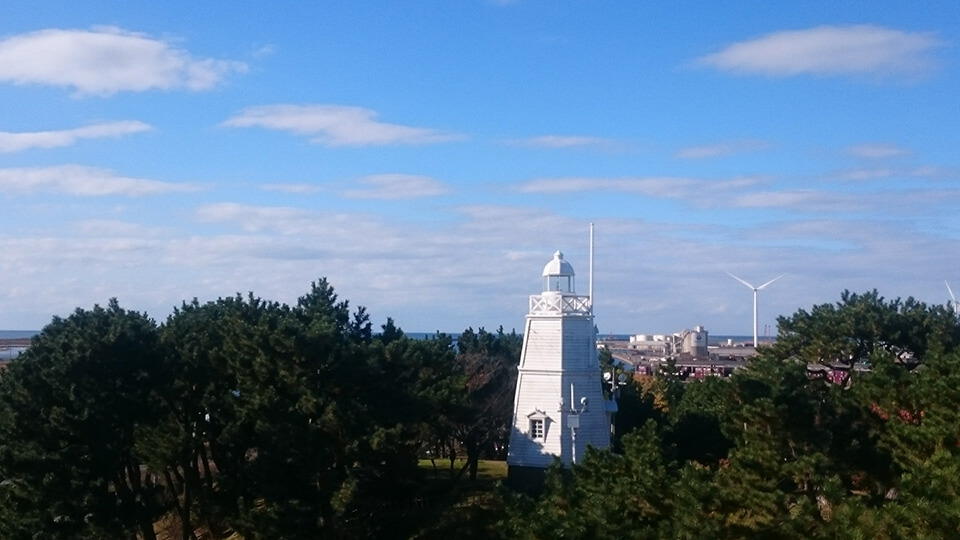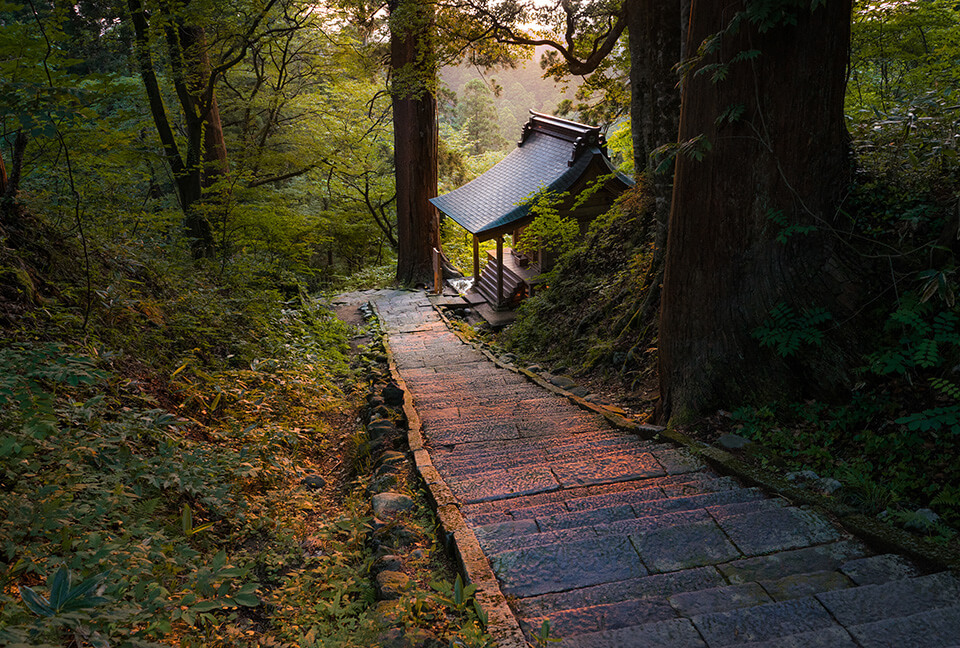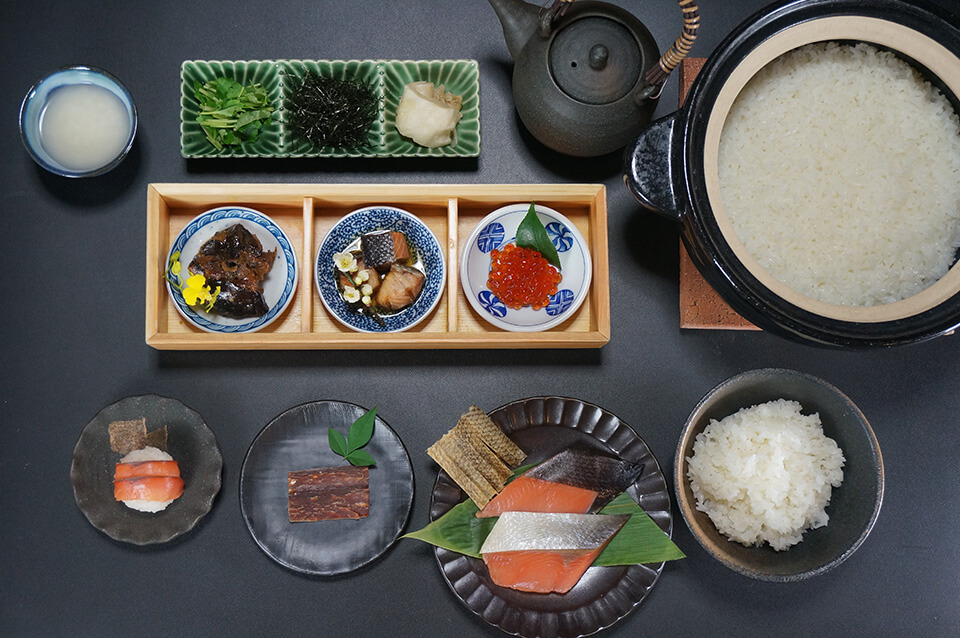This three day course takes you along the path that haiku master Matsuo Basho took while writing his famous work, “Oku no Hosomichi” (The Narrow Road to the Deep North). Experience the boat ride Basho took that inspired his famous rainy season haiku and visit Nikaho’s Kanmanji Temple and Kujuku Island, Sakata’s Hiyoriyama Park, Tsuruoka’s Mt. Haguro and Atsumi Hotspring, Murakami’s Jonenji Temple, and more in this course that spans three prefectures.
Itinerary
nights
days
Day One
01
Mogami River boat ride
Enjoy one of Japan’s top three rapid waters, the Mogami River on the Mogami Valley Basho Line Boat Ride. You can take this boat ride during any season of the year, and the views from the boat are spectacular in every season.


Enjoy the boatman’s fun talk and traditional songs as you move down the river.
For lunch, we recommend the Mogami Valley Basho Line’s on board lunch.
Click here for details
Mogami River Oshin Lunch Set: 1,600 yen (tax included),
Mogami River Lunch Set: 2,400 yen (tax included), and more (reservations required)
Departure times:
12:50 Depart 13:50 Arrive
13:50 Depart 14:50 Arrive
14:50 Depart 15:50 Arrive
15:30 Depart 16:30 Arrive
Note: There is a bus to return from Kusanagi to JR Furukuchi Station
02
Kanmanji Temple
Matsuo Basho visited this Soto school of Buddhism temple on his “Oku no Hosomichi” journey in 1689 when he visited Kisakata. Near the main temple are stones with Basho’s haiku engraved into them, cherry blossom trees, statues of important figures, and more.
Access: 15 minutes walking from JR Kisakata Station
Open hours: 8:00-17:00
Admission fee: 300 yen, High school students: 150 yen, Elementary students: 100 yen


03
Kujuku Island
Once admired as picturesque scenery along the ranks of Matsushima, it’s also known as Basho’s northernmost destination on his Oku no Hosomichi journey and was highly praised by the haiku poet. The Great Kisakata Earthquake in 1804 caused an uplift of land, changing the waters around the islands to dry land. Take a walk around the island, which was eventually filled with rice paddies and creates a unique island field scene that can’t be found anywhere else.
04
Kisakata Yuhi Sannemunoki
Sannemunoki is located along the natural monument Kisakata coastline, which inspired Basho’s famous poem line, “Kisagata rain lying asleep with wet flowers”. The inn’s hot spring comes from a colorless sulfur source and is said to give you silky smooth skin.


You can see the Sea of Japan from the large first floor bath, and Mt. Chokai from the third floor outlook bath. There’s also delicious food using fish from the Sea of Japan and vegetables taken from the foot of Mt. Chokai to be had.
Day Two
01
Homma Museum
Basho wandered through Yamagata for 40 days and stayed 9 of those days in Sakata. There are many areas related to Basho and haiku engravings located within the city. The Homma family, known as the number one landowners in Japan, built this country villa in 1813 and opened it as a museum starting in 1947. There are many Homma books, antiques, and paintings from the family’s collection on display. In summer, Matsuo Basho’s rare works will be displayed (late July to August 10th). The “Kakubuen” garden is also a highlight of the museum.
URL Click here for details
Access: 5 minute walk from Sakata Station
Open hours: April-October: 9:00-17:00 (entrance open until 16:30)
November-March: 9:00-16:30 (entrance open until 16:00)
Closed: Tuesdays & Wednesdays from December to February (if it’s a national holiday, closed the day after),
New Year’s.
Open every day from March to January


02
Hiyoriyama Park
There are Basho engraved haiku rocks and statues in the park famous for watching the sun set over the Sea of Japan.
Take a walk through the park while viewing Sakata’s prosperous history. You can find a 1:2 scale model of a Kitamaebune ship used long ago, Japan’s oldest wooden hexagon lighthouse, and more. Hiyoriyama Park is also a popular spot for viewing cherry blossoms in the spring.


03
Sakatakaisen Market
The fact that Sakata is a port city means that you get to enjoy all sorts of delicious food from the Sea of Japan. Next to Sakata’s harbor is the Sakatakaisen Market where you can find fresh fish straight out of Shonai’s shores and lots of restaurants and eating spots.
On the second floor, you’ll find “Seafood Don and Tobishima”, which serves seafood rice bowls and other small dishes that satisfy your need for fresh sea food.
Address: 2-chome-5-10 Funabacho, Sakata, Yamagata 998-0036
Business hours: “1F Sugawara Sengyo”: 8:00-18:00, “1F Kuikoiya Wan”: 11:00-15:00, 17:30-21:00, “2F Seafood Don and Tobishima”: 7:00-19:00


04
Mt. Haguro
Basho also visited the spiritually powerful Dewa Sanzan Mountains (Gassan, Haguro, Yudono). Japan’s greatest Grand Shrine, “Sanjin Gosaiden Shrine”, where the three gods of Dewa Sanzan are enshrined, is located at the top of the mountain.
The sacred feeling path to the summit includes the Five Storied Pagoda and the cedar avenue awarded three stars by the Michelin Green Guide Japan.
Access: (by bus)
• 50 minutes using the Mt. Haguro bus from Tsuruoka city (get off at the final stop)
• When using the stone steps up to the top of the mountain or when visiting the Haguro pagoda, use the same bus and get off at Zuishinmon


05
Atsumi Hot Spring
The area of Atsumi hot spring, with it’s soft, clear, and quiet waters, was another destination of Basho’s. From the warm waters to the delicious ingredients of the food, you’ll be delightfully overwhelmed by the warm-hearted care you’ll receive at the inns here.
The banks of the Atsumi River provide an excellent area to take a nature walk in every season with cherry blossoms in the spring, fishing in the summer, and migrating salmon in the fall. After checking into your inn, be sure to visit the Basho Memorial Stone on the path to Kumano Shrine.
Day Three
01
Jonenji Temple
Jonenji Temple is a Jodo temple known for being visited by Basho. The walls of the main temple are a rare white plaster. The temple is designated as an important cultural property.
Address: 3-13 Teramachi, Murakami, Niigata 958-0849
Access: 5 minute drive from Murakami Station


02
Izutsuya
For lunch, try “Izutsuya”, which is only a five minute walk from Jonenji Temple. It’s known as a pitstop on Matsu Basho’s journey and is designated as a national tangible cultural property.
Inside, well known restaurant Sennen Sake Kikkawa’s salted salmon is served, along with Iwafune koshihikari rice cooked in an earthenware pot. You can choose from seven course (1,950 yen), 10 course (2,900 yen) 13 course (3900 yen), 18 course (4,900 yen), and 21 course menus. *Prices don’t include tax.
URL Click here for details
Address: 1-12 Komachi, Murakami, Niigata 958-0841
Hours: 9:00-16:00 (Meals are from 11:00-16:00)
